Cassandra Budd: Mapping new paths
Suzette Chan - 16 April 2020
Cassandra Budd looked to the skies when she started university, but an invitation to take up a geophysics internship led her to change her major and to pursue a more grounded field of study. Now she’s been working across North America applying geophysics knowledge to engineering and environmental projects, such as assessing ice roads. She shared her story and her view of future paths in the geophysics industry.

Cassandra Budd on a snowmobile collecting ground-penetrating-radar ice thickness data via snowmobile on a project in the Northwest Territories. (Photo supplied.)
Can you tell us what made you choose Geophysics, and about your education and your professional career?
I started in the Astrophysics program at the University of Alberta. In my third year, I was offered a geophysics intern position through the Industrial Internship Program (now the Science Internship Program). I wasn’t 100% sure what geophysics was, but I was intrigued, so I took the intern position for 12 months. I was able to work all over western and northern Canada on a huge variety of near-surface geophysics projects and I quickly became hooked. I saw myself doing this as a career. The biggest draws for me were being able to travel to places I would otherwise never see (Baffin Island, diamond mines, etc.) and the variety of work.
Can you tell us about your current job?
I am a Project Geophysicist with Tetra Tech Canada, based in Edmonton. I work in near-surface geophysics focused on engineering and environmental applications. We use a wide variety of geophysical techniques to image the shallow subsurface including ground-penetrating-radar (GPR), electrical resistivity tomography (ERT), electromagnetic (EM), magnetometer, seismic, and downhole methods. Conducting GPR surveys to map ice thickness for ice roads has also led me to become an Ice Specialist with Tetra Tech. In the winter months I am involved with ice cover assessments and developing safety programs for on-ice work. This includes transportation of loads over ice covers as well as stationary loads (i.e., drilling programs).
Do you employ any skills, knowledge, or methods from your time in the geophysics program to your work now?
The majority of the methods that I use for my project fieldwork were covered in theory during geophysics coursework and in practice during geophysics field school. Geophysics Field School is a great opportunity to try out all of these methods and see how the theory is actually applied in the real world. A lot of the time fieldwork isn’t an ideal textbook situation and there are adjustments that have to be made during data collection. For anyone that will be using geophysics data, it is essential to understand what the field limitations and challenges are, as these can easily affect the collected data.
What part of your current job do you like?
I enjoy the opportunity to travel and work with different industries. I’ve been lucky enough to work in the Yukon, Northwest Territories, Nunavut, BC, Alberta, Saskatchewan, Alaska, Montana, Wisconsin, and Maine. Every job is different and you have to be constantly thinking about how to best apply a variety of geophysics methods to obtain your project objectives. It’s a job that allows me to continue learning.
What developments or trends do you see in the geophysical industry in the coming years?
I think we will see an increase in interdisciplinary teams for major projects, and that will result in increased use of geophysics to support these projects throughout their life cycle. We are also seeing an increase in remote sensing applications.
This profile is part of our Geophysics Careers series.